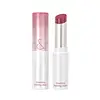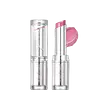What's inside
What's inside
 Key Ingredients
Key Ingredients

 Benefits
Benefits

 Concerns
Concerns

 Ingredients Side-by-side
Ingredients Side-by-side

Diisostearyl Malate
EmollientBis-Behenyl/Isostearyl/Phytosteryl Dimer Dilinoleyl Dimer Dilinoleate
EmollientPolyglyceryl-2 Triisostearate
EmulsifyingBis-Diglyceryl Polyacyladipate-2
EmollientParaffin
PerfumingTridecyl Trimellitate
EmollientPentaerythrityl Tetraisostearate
EmollientMicrocrystalline Wax
Emulsion StabilisingSorbitan Isostearate
EmulsifyingCI 77891
Cosmetic Colorant1,2-Hexanediol
Skin ConditioningDisteardimonium Hectorite
StabilisingSynthetic Wax
AbrasiveCI 19140
Cosmetic ColorantEthylene/Propylene Copolymer
AbrasiveCI 77491
Cosmetic ColorantPropylene Carbonate
SolventCI 15850
Cosmetic ColorantCI 77499
Cosmetic ColorantParfum
MaskingLimonene
PerfumingCI 42090
Cosmetic ColorantLinalool
PerfumingButyrospermum Parkii Butter
Skin ConditioningCamellia Japonica Seed Oil
EmollientCaprylic/Capric Triglyceride
MaskingArgania Spinosa Kernel Oil
EmollientSimmondsia Chinensis Seed Oil
EmollientPrunus Amygdalus Dulcis Oil
Skin ConditioningPrunus Armeniaca Kernel Oil
MaskingOenothera Biennis Oil
EmollientOlea Europaea Fruit
AbrasiveMangifera Indica Fruit Extract
Skin ConditioningRosa Canina Fruit Extract
AstringentDiisostearyl Malate, Bis-Behenyl/Isostearyl/Phytosteryl Dimer Dilinoleyl Dimer Dilinoleate, Polyglyceryl-2 Triisostearate, Bis-Diglyceryl Polyacyladipate-2, Paraffin, Tridecyl Trimellitate, Pentaerythrityl Tetraisostearate, Microcrystalline Wax, Sorbitan Isostearate, CI 77891, 1,2-Hexanediol, Disteardimonium Hectorite, Synthetic Wax, CI 19140, Ethylene/Propylene Copolymer, CI 77491, Propylene Carbonate, CI 15850, CI 77499, Parfum, Limonene, CI 42090, Linalool, Butyrospermum Parkii Butter, Camellia Japonica Seed Oil, Caprylic/Capric Triglyceride, Argania Spinosa Kernel Oil, Simmondsia Chinensis Seed Oil, Prunus Amygdalus Dulcis Oil, Prunus Armeniaca Kernel Oil, Oenothera Biennis Oil, Olea Europaea Fruit, Mangifera Indica Fruit Extract, Rosa Canina Fruit Extract
Caprylic/Capric Triglyceride
MaskingBis-Diglyceryl Polyacyladipate-2
EmollientHydrogenated Polyisobutene
EmollientOctyldodecanol
EmollientPentaerythrityl Tetraisostearate
EmollientSynthetic Wax
AbrasivePhytosteryl/Isostearyl/Cetyl/Stearyl/Behenyl Dimer Dilinoleate
Skin ConditioningHydrogenated Castor Oil Dimer Dilinoleate
Skin ConditioningIsoeicosane
EmollientSqualane
EmollientPolyethylene
AbrasiveTridecyl Trimellitate
EmollientCamellia Japonica Seed Oil
EmollientDimer Dilinoleyl Dimer Dilinoleate
EmollientPyrus Malus Seed Oil
EmollientDiisostearyl Malate
EmollientTitanium Dioxide
Cosmetic ColorantCocos Nucifera Oil
MaskingOpuntia Ficus-Indica Stem Extract
Skin ConditioningPolyglyceryl-2 Triisostearate
EmulsifyingDiglyceryl Sebacate/Isopalmitate
EmollientPolyglyceryl-2 Diisostearate
EmulsifyingPentaerythrityl Tetra-Di-T-Butyl Hydroxyhydrocinnamate
AntioxidantTrehalose
HumectantGlycerin
HumectantWater
Skin ConditioningTocopherol
AntioxidantDisodium Phosphate
BufferingCI 45410
Cosmetic ColorantCI 77492
Cosmetic ColorantCI 19140
Cosmetic ColorantCI 15850
Cosmetic ColorantCI 42090
Cosmetic ColorantParfum
MaskingCI 77491
Cosmetic ColorantCI 77499
Cosmetic ColorantCI 17200
Cosmetic ColorantCaprylic/Capric Triglyceride, Bis-Diglyceryl Polyacyladipate-2, Hydrogenated Polyisobutene, Octyldodecanol, Pentaerythrityl Tetraisostearate, Synthetic Wax, Phytosteryl/Isostearyl/Cetyl/Stearyl/Behenyl Dimer Dilinoleate, Hydrogenated Castor Oil Dimer Dilinoleate, Isoeicosane, Squalane, Polyethylene, Tridecyl Trimellitate, Camellia Japonica Seed Oil, Dimer Dilinoleyl Dimer Dilinoleate, Pyrus Malus Seed Oil, Diisostearyl Malate, Titanium Dioxide, Cocos Nucifera Oil, Opuntia Ficus-Indica Stem Extract, Polyglyceryl-2 Triisostearate, Diglyceryl Sebacate/Isopalmitate, Polyglyceryl-2 Diisostearate, Pentaerythrityl Tetra-Di-T-Butyl Hydroxyhydrocinnamate, Trehalose, Glycerin, Water, Tocopherol, Disodium Phosphate, CI 45410, CI 77492, CI 19140, CI 15850, CI 42090, Parfum, CI 77491, CI 77499, CI 17200
 Reviews
Reviews

Ingredients Explained
These ingredients are found in both products.
Ingredients higher up in an ingredient list are typically present in a larger amount.
This ingredient is lipid-based synthetic skin-conditioning agent derived from adipic acid and a mixture of fatty acids. It is often called a lanolin substitute.
As an emollient, it helps soften and hydrate the skin. Emollients create a barrier on the skin to trap moisture in.
Due to its fatty acid base, it may not be Malassezia folliculitis safe.
Learn more about Bis-Diglyceryl Polyacyladipate-2Camellia Japonica Seed Oil comes from the Japanese Camellia plant. This plant is native to East Asia and known as "Tsubaki" in Japanese.
Camellia Japonica Seed Oil is rich in oleic acid. This makes it a great emollient. Emollients help soften and soothe the skin by forming a barrier. This barrier traps moisture within, keeping your skin hydated.
This ingredient is an emollient, solvent, and texture enhancer. It is considered a skin-softener by helping the skin prevent moisture loss.
It helps thicken a product's formula and makes it easier to spread by dissolving clumping compounds.
Caprylic Triglyceride is made by combining glycerin with coconut oil, forming a clear liquid.
While there is an assumption Caprylic Triglyceride can clog pores due to it being derived from coconut oil, there is no research supporting this.
Learn more about Caprylic/Capric TriglycerideCi 15850 is the pigment color red. It is an azo dye and created synthetically.
Azo dyes need to be thoroughly purified before use. This allows them to be more stable and longer-lasting.
This ingredient is common in foundations, lipsticks, and blushes. This color is described as brown/orangey red.
It has many secondary names such as Red 6 and Red 7. According to a manufacturer, Red 6 usually contains aluminum.
Learn more about CI 15850CI 19140 is also known as Tartrazine. Tartrazine is a synthetic dye used in cosmetics, foods, and medicine to add a yellow color.
Tartrazine is created from petroleum and is water-soluble.
Some people may experience allergies from this dye, especially asthmatics and those with an aspirin intolerance.
Learn more about CI 19140Ci 42090 is a synthetic dye created from petroleum. It is used to give a bright blue color to cosmetics, medicine, and food.
Ci 77491 is also hydrated iron III oxide. It's sole purpose is to give a red/pink hue to products.
Iron III oxides are classified as inorganic chemicals for coloring.
Synthetically created Ci 77491 is considered safer than those naturally found. This is because the synthetically created version may contain less impurities. Iron oxides are generally non-toxic and non-allergenic.
Learn more about CI 77491Ci 77499 is also hydrated iron III oxide. It is created from mixing red and black iron oxides. This helps give shades of darkness to a product.
Iron III oxides are classified as inorganic chemicals for coloring.
Diisostearyl Malate is an emollient and most often used in lip products. It comes from isostearyl alcohol, a fatty acid, and malic acid, an AHA.
As an emollient, Diisostearyl Malate helps create a thin film on your skin to trap moisture in. This helps keep your skin soft and smooth.
Parfum is a catch-all term for an ingredient or more that is used to give a scent to products.
Also called "fragrance", this ingredient can be a blend of hundreds of chemicals or plant oils. This means every product with "fragrance" or "parfum" in the ingredients list is a different mixture.
For instance, Habanolide is a proprietary trade name for a specific aroma chemical. When used as a fragrance ingredient in cosmetics, most aroma chemicals fall under the broad labeling category of “FRAGRANCE” or “PARFUM” according to EU and US regulations.
The term 'parfum' or 'fragrance' is not regulated in many countries. In many cases, it is up to the brand to define this term.
For instance, many brands choose to label themselves as "fragrance-free" because they are not using synthetic fragrances. However, their products may still contain ingredients such as essential oils that are considered a fragrance by INCI standards.
One example is Calendula flower extract. Calendula is an essential oil that still imparts a scent or 'fragrance'.
Depending on the blend, the ingredients in the mixture can cause allergies and sensitivities on the skin. Some ingredients that are known EU allergens include linalool and citronellol.
Parfum can also be used to mask or cover an unpleasant scent.
The bottom line is: not all fragrances/parfum/ingredients are created equally. If you are worried about fragrances, we recommend taking a closer look at an ingredient. And of course, we always recommend speaking with a professional.
Learn more about ParfumPentaerythrityl Tetraisostearate is derived from isostearic acid. It is an emollient and emulsifier.
The highest concentration of this ingredient is found in lipsticks.
This ingredient is minimally water soluble and may not be Malassezia folliculitis, or fungal-acne safe.
Learn more about Pentaerythrityl TetraisostearateThis ingredient is a form of glycerin with emulsifying and emollient properties.
As an emulsifier, this ingredient helps keep products together while adding a thick texture. The manufacturer states this ingredient has emollient properties. Emollients help keep the skin hydrated by trapping moisture in.
Polyglyceryl-2 Triisostearate is created by reacting diglycerin and isostearic acid. Due to the isostearic acid base, it may not be safe for Malassezia or fungal acne.
Learn more about Polyglyceryl-2 TriisostearateSynthetic Wax is created from fossil fuels such as natural gas. It is used to enhance texture, adjust pH, and as an occlusive.
It may also be used as an abrasive ingredient to exfoliate the skin.
Synthetic Wax may not be fungal acne safe.
Learn more about Synthetic WaxTridecyl Trimellitate is a synthetic ingredient with emollient and skin conditioning properties. It also acts as a texture enhancer and helps products spread easily without feeling greasy.
As an emollient, it forms a light layer on the skin that keeps moisture in and improves water resistance. This is why you'll often find this ingredient in eye creams and other rich treatments.
This ingredient is seen as the elegant alternative to mineral oil.
Learn more about Tridecyl Trimellitate